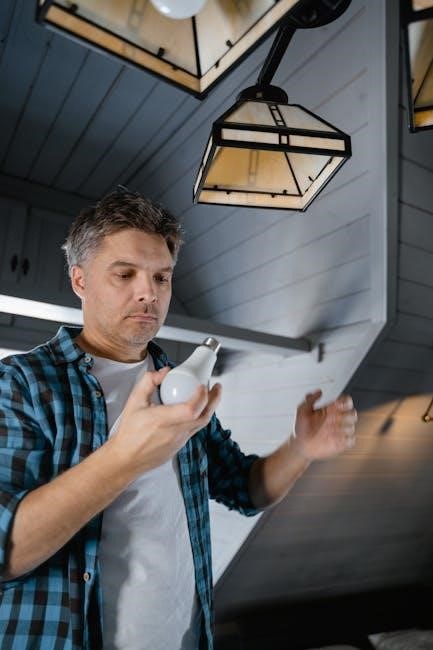The Arrma Vorteks ESC replacement is essential for maintaining optimal performance and reliability in your RC vehicle․ This guide provides step-by-step instructions to help you replace the ESC safely and effectively‚ ensuring your vehicle runs smoothly and efficiently․
1․1 Importance of ESC in RC Vehicles
The Electronic Speed Controller (ESC) is a critical component in RC vehicles‚ regulating motor speed‚ managing power delivery‚ and ensuring efficient energy use․ It acts as a bridge between the radio system and the motor‚ enabling precise control over acceleration and braking․ A functioning ESC prevents overheating‚ optimizes performance‚ and safeguards against potential damage․ Its advanced features‚ such as adjustable settings and thermal protection‚ make it indispensable for maintaining reliability and enhancing driving experiences in RC vehicles like the Arrma Vorteks․
1․2 Why Replace the ESC?
Replacing the ESC may be necessary due to damage‚ overheating‚ or the need for upgraded features․ Overheating‚ exceeding 105°C‚ can trigger thermal protection‚ reducing performance․ Water damage or physical stress may also require replacement․ Upgrading to a higher-quality ESC enhances reliability‚ improves thermal management‚ and unlocks advanced settings like adjustable power delivery․ Ensuring optimal performance and preventing potential damage makes ESC replacement a crucial step in maintaining your Arrma Vorteks’ peak functionality and longevity․
1․3 Brief Overview of the Replacement Process
Replacing the ESC in your Arrma Vorteks involves several key steps: disconnecting the battery‚ removing the old ESC‚ and installing a new one․ Ensure you have the right tools and follow safety precautions to avoid damage․ Start by locating the ESC‚ then carefully disconnect it from the vehicle’s electronics․ Install the new ESC‚ ensuring proper mounting and secure connections․ Reconnect the battery and test the system to confirm everything works as expected․ Visit ARRMA-RC․com for official guidance and support․

Preparing for ESC Replacement
Ensure you have the right tools‚ follow safety guidelines‚ and understand the electronics system․ Check components for damage and prepare a safe workspace for the replacement process;
2․1 Tools and Materials Needed
To replace the ESC in your Arrma Vorteks‚ you’ll need a few essential tools and materials․ Start with a screwdriver set for disassembling the vehicle‚ pliers for handling wires‚ and a soldering iron for any necessary wiring repairs․ A computer or laptop is required for updating the ESC firmware․ Additionally‚ ensure you have safety gear like gloves and a fire-resistant bag․ Gather replacement parts‚ such as a compatible ESC‚ and have a clean‚ well-lit workspace ready for the procedure․
2․2 Safety Precautions
Before starting the ESC replacement‚ ensure the battery is disconnected to prevent any accidental power-up․ Wear protective gloves and eyewear to safeguard against potential electrical hazards․ Work in a well-ventilated area‚ away from flammable materials․ Avoid touching electrical components with bare hands to prevent static discharge․ Keep a fire extinguisher nearby as a precaution․ Always follow the manufacturer’s guidelines and ensure the vehicle is on a stable‚ flat surface during the process․
2․3 Understanding the Arrma Vorteks Electronics System
The Arrma Vorteks electronics system integrates the ESC‚ motor‚ and radio components seamlessly․ The ESC controls power distribution to the motor‚ while the radio system ensures precise control․ Understanding these connections is crucial for a successful replacement․ Familiarize yourself with the wiring layout and component locations to avoid damage during the process․ Proper alignment and secure connections ensure optimal performance and safety․ This knowledge will help you navigate the replacement efficiently and effectively‚ maintaining your vehicle’s reliability and speed․

Disconnecting the Old ESC
Disconnecting the old ESC involves safely removing the battery‚ detaching motor and component connections‚ and carefully extracting the ESC from the vehicle for replacement․
3․1 Locating the ESC in the Arrma Vorteks
The ESC in the Arrma Vorteks is typically found in the vehicle’s electronics compartment‚ often near the receiver and battery for efficient power distribution․ To access it‚ remove the top deck by taking out the screws․ Once inside‚ identify the ESC by its heat sink and wiring connections․ Ensure you handle it carefully to avoid damage․ Always disconnect the battery before working on the ESC to prevent any accidental power-ups or electrical hazards․
3․2 Safely Disconnecting the Battery
To ensure safety‚ start by locating the battery compartment in your Arrma Vorteks․ Open it and find the battery․ Use a wrench or screwdriver to disconnect the negative terminal first‚ followed by the positive terminal․ This prevents any accidental short circuits․ Once disconnected‚ wait a few moments to allow any capacitors in the system to discharge․ Never skip this step‚ as it protects both you and your vehicle’s electronics from potential damage․ Always handle the battery carefully to avoid spills or physical harm․
3․3 Removing the ESC from the Vehicle
After disconnecting the battery‚ locate the ESC in your Arrma Vorteks․ Gently remove any screws or clips securing it to the chassis․ Carefully pull the ESC away from its mounting position‚ ensuring no wires are tangled or damaged․ If the ESC is stuck‚ wiggle it slightly to dislodge it․ Once removed‚ inspect the ESC for any remaining connections‚ such as sensor wires or motor leads‚ and disconnect them if necessary․ Handle the ESC by the heat sink to avoid damage to the components․

Installing the New ESC
Mount the new ESC in the designated area‚ ensuring it is securely fastened with screws․ Reconnect the motor‚ battery‚ and radio system wires carefully․ Handle the ESC by the heat sink to avoid damage‚ ensuring proper seating and alignment for optimal performance․
4․1 Choosing the Right Replacement ESC
Choosing the right ESC for your Arrma Vorteks is crucial for optimal performance and reliability․ Ensure the ESC is compatible with your motor and battery specifications to avoid damage․ Consider the voltage rating‚ current capacity‚ and whether it’s sensored or brushless․ A Hobbywing Quicrun 10BL120 or Spektrum Firma 130A ESC are excellent choices‚ offering programmability and reliable cooling systems․ Always check reviews and manufacturer support to confirm compatibility and performance‚ ensuring smooth operation and preventing overheating issues․
4․2 Mounting the New ESC
Mounting the new ESC requires careful placement to ensure proper cooling and functionality․ Use the original mounting hardware to secure the ESC firmly in its designated slot․ Ensure the ESC is aligned correctly with the vehicle’s electronics system․ If using a Spektrum Firma 130A ESC or similar‚ check for any slight offset in mounting posts and adjust accordingly․ Secure the ESC with screws‚ ensuring it is snug but not over-tightened to avoid damage․ Double-check the placement for proper thermal management and accessibility of connections․ Ensure no wires or components obstruct the ESC’s airflow for optimal performance․
4․3 Reconnecting the ESC to the Vehicle
Reconnecting the new ESC involves securely attaching it to the motor‚ battery‚ and receiver․ Ensure all connections are tight and properly insulated to prevent short circuits․ Follow the wiring diagram from the manual or manufacturer’s instructions․ Bind the ESC to the radio system by syncing it with the receiver‚ as outlined in the binding procedure․ Once connected‚ calibrate the ESC by following the calibration steps to ensure proper throttle and brake response․ Double-check all connections for reliability and optimal performance․

Configuring the New ESC
Configuring the new ESC ensures optimal performance and compatibility with your Arrma Vorteks․ This process includes binding the ESC to the radio system‚ calibrating it‚ and updating firmware for enhanced features and reliability․
5․1 Binding the ESC to the Radio System
Binding the new ESC to your radio system ensures seamless communication between components․ Start by turning off both the ESC and radio․ Connect the battery to the ESC‚ then turn on the radio․ Locate the binding button on the ESC and press and hold it while turning on the radio․ Release the button when the ESC and radio sync‚ confirmed by a light or beep․ Test the throttle and brakes to ensure proper function․ Repeat if necessary and consult the manual for specific instructions․
5․2 Calibrating the ESC
Calibrating the ESC ensures proper throttle and brake response․ Start by plugging in the battery and entering the ESC’s setup mode‚ typically done by pressing and holding the setup button․ Use the radio to set the throttle and brake endpoints‚ following the on-screen or manual instructions․ Adjust the settings to match your desired performance․ Save the changes and perform a test run to verify smooth operation․ Proper calibration is crucial for optimal control and safety․ Always refer to the ESC manual for specific calibration steps․
5․3 Updating ESC Firmware
Updating the ESC firmware enhances performance and adds new features․ Connect the ESC to your PC using a programmer or USB adapter‚ ensuring the correct drivers are installed․ Download the latest firmware from the official Arrma website or manufacturer’s portal․ Follow the software instructions to flash the firmware‚ taking care to avoid interruptions․ Once updated‚ disconnect the ESC and bind it to your radio system․ Perform a test run to verify functionality․ Regular updates ensure optimal compatibility and performance․

Testing and Verification
After installation‚ perform a thorough test to ensure the ESC functions correctly․ Check initial startup‚ throttle response‚ and brake performance․ Verify ESC temperature stays within safe limits․
6․1 Initial Startup and Functionality Check
Power on the vehicle and ensure the ESC initializes without error lights or beeps․ Plug in the battery and verify the ESC activates properly‚ checking for any immediate issues․ Monitor the motor for unusual behavior and ensure all components respond to throttle and brake inputs․ Confirm the ESC does not overheat during initial operation‚ staying below 105°C to prevent thermal shutdown․ Verify smooth functionality and proper communication between the ESC and other electronics․
6․2 Testing Throttle and Brake Response
Gradually increase the throttle to ensure smooth acceleration and consistent power delivery․ Test the brake response by slowing down and stopping to verify proper function․ Check for any jerky movements or unexpected behavior․ Listen for unusual motor or ESC noises during operation․ Test on a flat surface to ensure even performance․ If issues arise‚ adjust settings or recheck connections․ Ensure the ESC and motor operate within safe temperature limits during testing․
6․3 Verifying ESC Temperature and Performance
After installation‚ monitor the ESC’s temperature during operation to ensure it stays within safe limits․ Use a temperature gun for accurate readings․ If the ESC exceeds 105°C‚ it may enter thermal protection mode‚ reducing power or shutting down․ Check for proper cooling and ensure no debris blocks airflow․ Verify smooth acceleration and deceleration․ If the ESC shows signs of damage or malfunction‚ replace it immediately․ Always refer to the manual for specific temperature guidelines and performance expectations․

Post-Installation Checks
Ensure proper cooling‚ check for error messages‚ and inspect all connections․ Verify ESC temperature stays below 105°C and performance remains consistent during operation․
7․1 Ensuring Proper Cooling
Ensuring proper cooling is critical for the longevity of your Arrma Vorteks ESC․ After installation‚ check that the ESC is mounted in a well-ventilated area․ Remove any debris that might block airflow․ Consider upgrading to a high-quality cooling fan if you frequently operate in high-temperature environments or at high speeds․ Proper cooling prevents overheating‚ which can damage the ESC․ Regularly inspect the cooling system to ensure it’s functioning effectively․
7․2 Checking for Any Error Messages
After replacing the ESC‚ it’s crucial to check for any error messages․ Use your radio system to monitor the ESC’s status․ Look for LED indicators or alarm sounds that signal issues․ Refer to the manual to interpret error codes․ Common problems include overheating or improper connections․ Address any errors immediately to prevent damage․ If issues persist‚ consult the official Arrma documentation or contact support for assistance․ Regular checks ensure optimal performance and reliability of your Arrma Vorteks․
7․3 Final Inspection of Connections
Perform a thorough inspection of all connections after ESC replacement․ Ensure the motor‚ battery‚ and radio wires are securely plugged in․ Verify solder joints for any signs of damage or wear․ Check for proper mounting of the ESC to avoid vibration issues․ Test all connections by gently tugging on the wires․ A secure setup prevents intermittent operation and enhances overall performance․ This step is vital for the longevity and reliability of your Arrma Vorteks’s electronics system․

Maintenance and Upkeep
Regular maintenance ensures the ESC operates efficiently․ Clean dirt and debris‚ monitor temperatures‚ and update firmware to maintain optimal performance and extend the ESC’s lifespan effectively․
8․1 Cleaning the ESC
Cleaning the ESC is crucial for maintaining its performance and preventing overheating․ Power down the vehicle and disconnect the battery before cleaning․ Use compressed air to gently remove dirt and debris from the ESC’s surface and heat sink․ Avoid using liquids or harsh chemicals‚ as they may damage the electronics․ Inspect the ESC for any physical damage or worn connections․ Regular cleaning ensures proper heat dissipation and reliable operation‚ extending the lifespan of your Arrma Vorteks ESC․
8․2 Monitoring ESC Temperature
Monitoring the ESC temperature is vital to prevent overheating and ensure optimal performance․ Use a thermometer or rely on built-in temperature sensors to track ESC heat levels․ Refer to the manual for specific temperature thresholds‚ typically around 105°C․ If the ESC overheats‚ it may reduce power or shut down․ Ensure proper airflow and cooling to maintain safe temperatures․ Regularly inspect the ESC for thermal damage and clean debris that could obstruct heat dissipation․ This proactive approach prevents damage and extends the ESC’s lifespan in your Arrma Vorteks․
8․3 Regular Software Updates
Regular software updates are essential for maintaining the performance and functionality of your Arrma Vorteks ESC․ These updates often include new features‚ bug fixes‚ and performance improvements․ Use the official Arrma or Spektrum programming tools to update your ESC firmware․ Always follow the instructions provided in the manual or online resources to ensure a smooth update process․ Updating your ESC regularly will enhance its reliability‚ optimize motor control‚ and prevent potential issues during operation‚ ensuring your RC vehicle runs at its best․

Troubleshooting Common Issues
Identify and resolve common issues such as motor recognition problems‚ overheating‚ or power loss․ Consult the manual or online forums for detailed troubleshooting solutions and guidance․
9․1 ESC Not Recognizing the Motor
If the ESC fails to recognize the motor‚ ensure proper connections and check for loose wires․ Verify motor compatibility with the ESC and update the firmware․ Reset the ESC by disconnecting the battery and reconnecting it․ If issues persist‚ refer to the manual or manufacturer support for further assistance․ This step-by-step approach helps resolve recognition problems efficiently․
9․2 Overheating Problems
Overheating issues may arise if the ESC exceeds 105°C․ Ensure proper cooling by installing fans or heatsinks․ Check for excessive load or high-speed operations․ Verify wiring and connections for shorts․ Reduce heat buildup by upgrading to a high-efficiency ESC; Monitor temperature during use and avoid overloading․ Regularly clean the ESC to maintain airflow․ Addressing overheating promptly prevents damage and ensures reliable performance․
9․3 Loss of Power or Intermittent Operation
Loss of power or intermittent operation can occur due to faulty connections or damaged wiring․ Check all wires for breaks or corrosion․ Ensure the ESC is properly calibrated and bound to the radio system․ If issues persist‚ reset the ESC to factory settings or update its firmware․ Verify that the motor and ESC are compatible․ In severe cases‚ replacing the ESC may be necessary to restore consistent performance․

Resources and Support
For assistance‚ refer to official Arrma documentation‚ visit community forums for shared experiences‚ or contact Arrma support directly for professional guidance and troubleshooting help․
10․1 Official Arrma Documentation
The official Arrma manual provides detailed instructions on safety‚ operation‚ and maintenance․ It includes specific guidelines for ESC replacement‚ troubleshooting‚ and upgrading․ Ensure to review all warnings and recommendations to avoid damage or performance issues․ The manual also highlights critical information‚ such as temperature limits (e․g․‚ 105°C) and essential steps for firmware updates․ Visit ARRMA-RC․com for the latest resources and support materials to ensure a successful ESC replacement and optimal vehicle performance․
10․2 Community Forums and Discussions
Community forums and discussions offer a wealth of information and firsthand experiences for Arrma Vorteks ESC replacement․ Enthusiasts share tips on upgrading to brushless systems‚ such as the Spektrum Firma 130A ESC‚ and troubleshooting common issues․ Users also discuss compatible motors and cooling solutions‚ providing practical advice for optimal performance․ These platforms are invaluable for resolving specific problems‚ such as firmware updates or binding procedures‚ and offer real-world insights to ensure a successful ESC replacement and enhance your RC driving experience․
10․3 Contacting Arrma Support
Contacting Arrma Support is crucial for resolving complex ESC-related issues or obtaining official guidance․ Their team provides expert assistance‚ troubleshooting‚ and recommendations for upgrades or repairs․ Visit the official Arrma website or contact their support directly for personalized help․ This resource is especially valuable for addressing warranty claims or rare problems not covered in manuals․ Arrma Support ensures you receive reliable solutions tailored to your Vorteks model‚ helping you maintain peak performance and resolve any ESC replacement challenges effectively and efficiently․
Replacing the ESC in your Arrma Vorteks enhances performance and reliability‚ allowing for future upgrades․ Regular maintenance ensures durability and optimal functionality‚ safeguarding your investment․
11․1 Final Thoughts on ESC Replacement
Replacing the ESC in your Arrma Vorteks is a straightforward process that significantly enhances performance and reliability․ By following the provided instructions‚ you can ensure a smooth upgrade․ Regular maintenance and updates will keep your vehicle running optimally․ Always refer to official guides and community forums for the latest advice and troubleshooting tips․ Proper installation and care will extend the life of your ESC and maintain your RC vehicle’s peak performance levels over time․
11․2 Encouragement for Further Upgrades
After successfully replacing your Arrma Vorteks ESC‚ consider exploring other upgrades to maximize performance․ Upgrading the motor‚ battery‚ or cooling system can further enhance speed and efficiency․ Ensure compatibility with your new ESC for optimal results․ Research community recommendations and official guides for tailored advice․ Regularly checking for firmware updates and maintaining your vehicle will keep it running at its best․ Embrace the hobby’s creative aspect and enjoy the improved performance of your Arrma Vorteks․
11․3 Importance of Proper Maintenance
Proper maintenance is crucial to ensure the longevity and performance of your Arrma Vorteks after an ESC replacement․ Regularly clean the ESC‚ monitor its temperature‚ and update firmware to prevent damage․ Overheating can lead to reduced efficiency or permanent damage‚ so ensure cooling systems function correctly․ Refer to the official Arrma manual for specific maintenance schedules and guidelines․ Consistent upkeep not only enhances performance but also prevents unexpected issues‚ keeping your RC vehicle running smoothly for years to come․

